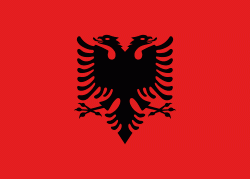Mafsheq
Mafsheq is a village located in the Durrës County, in Albania. At the 2015 local government reform it became part of the municipality Krujë. Historically the village of Mafsheq has been part of Kurbin District. Mafsheq is separated from Kruje region by Shkreta creek (Albanian: prroji i Shkretes) and the famous Weeping Gorge (Albanian: Gryka e vajes), where after the fall of the city of Kruja to the Ottomans in the 14th century AD, about ninety ethnic Albanian women jumped from a nearby cliff to their death.
The village of Mafsheq is located on a mountain slope just above the old village (Albanian: Katuni i vjeter) where three creeks meet and form the Droja River (Albanian: lumi i Drojes). Mafsheq has a mild Mediterranean mountain climate and there is limited pollution. The area is suitable for hiking and a source of herbs. The water is clean, and there are caves and ancient ruins which date back thousands of years. There are Albanian-constructed stone homes that are hundreds of years old, and have Judeo-Christian symbols carved on them, such as "Kulla Likes" or "Kulla e Beges". Not many live there as most have moved down to Kruja or Fush-kruja but there are still people who live there. Mafsheq has also small rivers contain crystal clean water like the river (Gurrat). Mafsheq is also known for the people that have jumped off cliffs and died there are also small family grave sites. There are also big farms that the villagers look after.
The village of Mafsheq is located on a mountain slope just above the old village (Albanian: Katuni i vjeter) where three creeks meet and form the Droja River (Albanian: lumi i Drojes). Mafsheq has a mild Mediterranean mountain climate and there is limited pollution. The area is suitable for hiking and a source of herbs. The water is clean, and there are caves and ancient ruins which date back thousands of years. There are Albanian-constructed stone homes that are hundreds of years old, and have Judeo-Christian symbols carved on them, such as "Kulla Likes" or "Kulla e Beges". Not many live there as most have moved down to Kruja or Fush-kruja but there are still people who live there. Mafsheq has also small rivers contain crystal clean water like the river (Gurrat). Mafsheq is also known for the people that have jumped off cliffs and died there are also small family grave sites. There are also big farms that the villagers look after.
Map - Mafsheq
Map
Country - Albania
 |
 |
| Flag of Albania | |
Albania has been inhabited by different civilisations over time, such as the Illyrians, Thracians, Ancient Greeks, Romans, Byzantines, Venetians, and Ottomans. The Albanians established the autonomous Principality of Arbër in the 12th century. The Kingdom of Albania and Principality of Albania formed between the 13th and 14th centuries. Prior to the Ottoman conquest of Albania in the 15th century, the Albanian resistance to Ottoman expansion into Europe led by Skanderbeg won them acclaim over most of Europe. Albania remained under Ottoman rule for nearly five centuries, during which many Albanians (known as Arnauts) attained high-ranking offices in the empire, especially in the Southern Balkans and Egypt. Between the 18th and 19th centuries, cultural developments, widely attributed to Albanians having gathered both spiritual and intellectual strength, conclusively led to the Albanian Renaissance. After the defeat of the Ottomans in the Balkan Wars, the modern nation state of Albania declared independence in 1912. In the 20th century, the Kingdom of Albania was invaded by Italy, which formed Greater Albania before becoming a protectorate of Nazi Germany. Enver Hoxha formed the People's Socialist Republic of Albania after World War II, modeled under the terms of Hoxhaism. The Revolutions of 1991 concluded the fall of communism in Albania and eventually the establishment of the current Republic of Albania.
Currency / Language
| ISO | Currency | Symbol | Significant figures |
|---|---|---|---|
| ALL | Albanian lek | L | 2 |
| ISO | Language |
|---|---|
| SQ | Albanian language |
| EL | Greek language |















